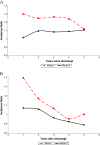Long-term survival and healthcare utilization outcomes attributable to sepsis and pneumonia
- PMID: 23181764
- PMCID: PMC3534544
- DOI: 10.1186/1472-6963-12-432
Long-term survival and healthcare utilization outcomes attributable to sepsis and pneumonia
Abstract
Background: Hospital associated infections are major problems, which are increasing in incidence and very costly. However, most research has focused only on measuring consequences associated with the initial hospitalization. We explored the long-term consequences of infections in elderly Medicare patients admitted to an intensive care unit (ICU) and discharged alive, focusing on: sepsis, pneumonia, central-line-associated bloodstream infections (CLABSI), and ventilator-associated pneumonia (VAP); the relationships between the infections and long-term survival and resource utilization; and how resource utilization was related to impending death during the follow up period.
Methods: Clinical data and one year pre- and five years post-index hospitalization Medicare records were examined. Hazard ratios (HR) and healthcare utilization incidence ratios (IR) were estimated from state of the art econometric models. Patient demographics (i.e., age, gender, race and health status) and Medicaid status (i.e., dual eligibility) were controlled for in these models.
Results: In 17,537 patients, there were 1,062 sepsis, 1,802 pneumonia, 42 CLABSI and 52 VAP cases. These subjects accounted for 62,554 person-years post discharge. The sepsis and CLABSI cohorts were similar as were the pneumonia and VAP cohorts. Infection was associated with increased mortality (sepsis HR = 1.39, P < 0.01; and pneumonia HR = 1.58, P < 0.01) and the risk persisted throughout the follow-up period. Persons with sepsis and pneumonia experienced higher utilization than controls (e.g., IR for long-term care utilization for those with sepsis ranged from 2.67 to 1.93 in years 1 through 5); and, utilization was partially related to impending death.
Conclusions: The infections had significant and lasting adverse consequences among the elderly. Yet, many of these infections may be preventable. Investments in infection prevention interventions are needed in both community and hospitals settings.
Figures


References
Publication types
MeSH terms
Grants and funding
LinkOut - more resources
Full Text Sources
Medical

